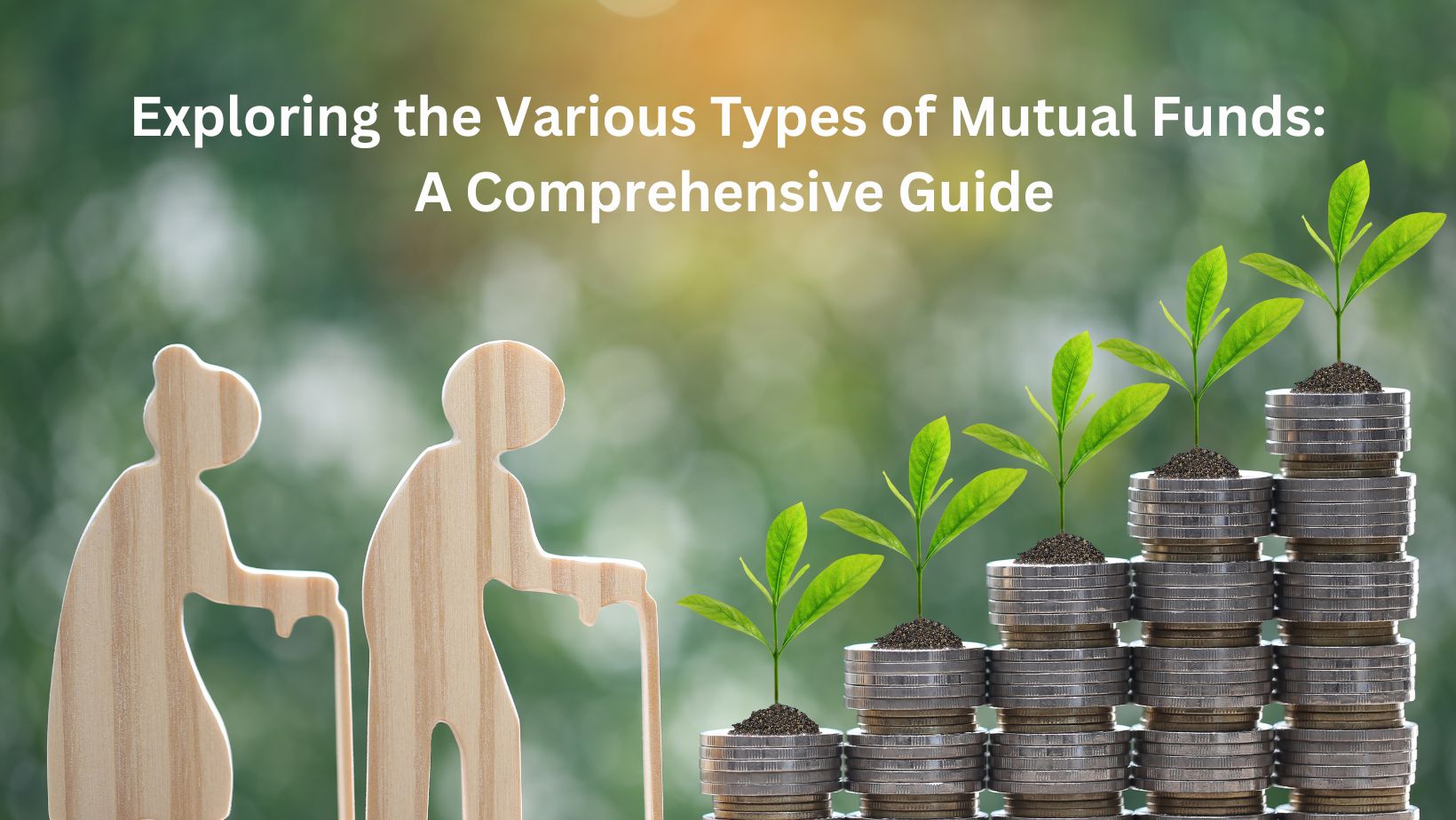Exploring the Various Types of Mutual Funds: A Comprehensive Guide
Mutual funds are a popular investment vehicle that pools money from multiple investors to invest in a diverse range of securities such as stocks, bonds, and other assets. One of the key advantages of mutual funds is their ability to offer diversification and professional management to investors with varying risk appetites and investment goals. In this comprehensive guide, we'll delve into the different types of mutual funds available in the market, each catering to specific investment objectives and preferences.
1. Equity Funds:
Equity funds invest primarily in stocks or equities, offering investors the potential for long-term capital appreciation. These funds may focus on specific market segments such as large-cap, mid-cap, or small-cap stocks, or they may follow a thematic approach by investing in sectors like technology, healthcare, or energy. Equity funds tend to be more volatile compared to other types of mutual funds due to the inherent risks associated with stock market fluctuations.
2. Fixed-Income Funds:
Fixed-income funds, also known as bond funds, invest in a portfolio of bonds issued by governments, corporations, or other entities. These funds aim to provide investors with regular income through interest payments while preserving capital. Fixed-income funds vary in terms of the types of bonds they hold, including government bonds, corporate bonds, municipal bonds, and high-yield bonds. They are generally considered less risky than equity funds but may still be subject to interest rate and credit risk.
3. Balanced Funds:
Balanced funds, also referred to as hybrid funds, invest in a mix of stocks and bonds to achieve a balanced portfolio. These funds aim to provide both capital appreciation and income generation while managing overall portfolio risk. Balanced funds typically maintain a predetermined asset allocation between equities and fixed-income securities, with variations based on the fund manager's investment strategy and market conditions.
4. Money Market Funds:
Money market funds invest in short-term, low-risk securities such as Treasury bills, certificates of deposit (CDs), and commercial paper. These funds aim to preserve capital and provide investors with liquidity and stability. Money market funds are often used as a cash management tool or as a temporary parking place for funds awaiting investment in other asset classes. While they offer lower returns compared to equity or fixed-income funds, they are considered relatively safe investments.
5. Specialty Funds:
Specialty funds focus on specific sectors, themes, or investment strategies that may not be covered by traditional mutual funds. Examples of specialty funds include sector funds (e.g., technology, healthcare), thematic funds (e.g., renewable energy, artificial intelligence), and alternative investment funds (e.g., real estate, commodities). Specialty funds may offer investors the opportunity to capitalize on niche market trends or unique investment opportunities but may also carry higher risk and volatility.
6. Index Funds:
Index funds seek to replicate the performance of a specific market index, such as the S&P 500 or the FTSE 100, by holding a portfolio of securities that closely mirrors the index's composition. These funds aim to provide investors with returns that closely track the overall market while offering lower fees compared to actively managed funds. Index funds are popular among investors seeking broad market exposure and passive investment strategies.
7. Exchange-Traded Funds (ETFs):
While technically not mutual funds, ETFs share many similarities with mutual funds in terms of structure and investment approach. ETFs are traded on stock exchanges like individual stocks and offer investors exposure to a wide range of asset classes, sectors, and investment strategies. Like index funds, ETFs can provide low-cost, diversified investment options and are suitable for both short-term trading and long-term investing.
In conclusion, the world of mutual funds offers a diverse array of investment options tailored to meet the varying needs and preferences of investors. Whether you're seeking growth, income, capital preservation, or a combination of these objectives, there's likely a mutual fund that aligns with your investment goals. By understanding the different types of mutual funds and their characteristics, investors can make informed decisions to build a well-rounded investment portfolio suited to their individual financial circumstances and aspirations.
For more information visit us @ https://freestudyspace.com/types-of-mutual-funds/
People
Circles
Posts
Bitcoin Halving 2024 presents a significant opportunity for investors to capitalize on the potential price appreciation of Bitcoin. By understanding the significance of halving events, analyzing historical data, and implementing sound investment strategies, investors can position themselves to unlock profit opportunities and navigate the dynamic landscape of the cryptocurrency market. As with any investment, it's essential to exercise caution, conduct thorough research, and seek professional financial advice if needed. With careful planning and prudent decision-making, investors can potentially reap the rewards of Bitcoin's next halving event and participate in the ongoing evolution of the digital asset ecosystem.
https://goonus.io/3-bi-quyet-kiem-loi-tu-bitcoin-halving/
Cuz ALL I see is COWARDS of U so called 'MORE of' (us?) than THEM ie: WE THE PEOPLE, $ HAVES having so much = don't even know what U got & got no appreciation of along with NO regard 4 NOTHING as with THEM (fill in the blanks) 2 Coming MORE literally destroy & CEASE EVERYTHING human (created in LESS than a day & given ALL it'd EVER need 2 exhibit SELF denyingly Warrior right-proper) - non human - Earth and ALL on Earth & ALL off Earth 2 where WHAT? God created Earth in originally 5 days, us humanity in LESS than a day ALL 4 WHAT, especially this day in age 2 date (year) AD, look around as literally NOTHING resembles in ANY capacity what we humanity were SUPPOSE 2 B & WHAT? U ALL gonna try & blame God? Sigh ugh, whatever, so B it, REAP HIS wrath = Coming!
Videos
People
Circles
Videos
Posts
Exploring the Various Types of Mutual Funds: A Comprehensive Guide
Mutual funds are a popular investment vehicle that pools money from multiple investors to invest in a diverse range of securities such as stocks, bonds, and other assets. One of the key advantages of mutual funds is their ability to offer diversification and professional management to investors with varying risk appetites and investment goals. In this comprehensive guide, we'll delve into the different types of mutual funds available in the market, each catering to specific investment objectives and preferences.
1. Equity Funds:
Equity funds invest primarily in stocks or equities, offering investors the potential for long-term capital appreciation. These funds may focus on specific market segments such as large-cap, mid-cap, or small-cap stocks, or they may follow a thematic approach by investing in sectors like technology, healthcare, or energy. Equity funds tend to be more volatile compared to other types of mutual funds due to the inherent risks associated with stock market fluctuations.
2. Fixed-Income Funds:
Fixed-income funds, also known as bond funds, invest in a portfolio of bonds issued by governments, corporations, or other entities. These funds aim to provide investors with regular income through interest payments while preserving capital. Fixed-income funds vary in terms of the types of bonds they hold, including government bonds, corporate bonds, municipal bonds, and high-yield bonds. They are generally considered less risky than equity funds but may still be subject to interest rate and credit risk.
3. Balanced Funds:
Balanced funds, also referred to as hybrid funds, invest in a mix of stocks and bonds to achieve a balanced portfolio. These funds aim to provide both capital appreciation and income generation while managing overall portfolio risk. Balanced funds typically maintain a predetermined asset allocation between equities and fixed-income securities, with variations based on the fund manager's investment strategy and market conditions.
4. Money Market Funds:
Money market funds invest in short-term, low-risk securities such as Treasury bills, certificates of deposit (CDs), and commercial paper. These funds aim to preserve capital and provide investors with liquidity and stability. Money market funds are often used as a cash management tool or as a temporary parking place for funds awaiting investment in other asset classes. While they offer lower returns compared to equity or fixed-income funds, they are considered relatively safe investments.
5. Specialty Funds:
Specialty funds focus on specific sectors, themes, or investment strategies that may not be covered by traditional mutual funds. Examples of specialty funds include sector funds (e.g., technology, healthcare), thematic funds (e.g., renewable energy, artificial intelligence), and alternative investment funds (e.g., real estate, commodities). Specialty funds may offer investors the opportunity to capitalize on niche market trends or unique investment opportunities but may also carry higher risk and volatility.
6. Index Funds:
Index funds seek to replicate the performance of a specific market index, such as the S&P 500 or the FTSE 100, by holding a portfolio of securities that closely mirrors the index's composition. These funds aim to provide investors with returns that closely track the overall market while offering lower fees compared to actively managed funds. Index funds are popular among investors seeking broad market exposure and passive investment strategies.
7. Exchange-Traded Funds (ETFs):
While technically not mutual funds, ETFs share many similarities with mutual funds in terms of structure and investment approach. ETFs are traded on stock exchanges like individual stocks and offer investors exposure to a wide range of asset classes, sectors, and investment strategies. Like index funds, ETFs can provide low-cost, diversified investment options and are suitable for both short-term trading and long-term investing.
In conclusion, the world of mutual funds offers a diverse array of investment options tailored to meet the varying needs and preferences of investors. Whether you're seeking growth, income, capital preservation, or a combination of these objectives, there's likely a mutual fund that aligns with your investment goals. By understanding the different types of mutual funds and their characteristics, investors can make informed decisions to build a well-rounded investment portfolio suited to their individual financial circumstances and aspirations.
For more information visit us @ https://freestudyspace.com/types-of-mutual-funds/
Bitcoin Halving 2024 presents a significant opportunity for investors to capitalize on the potential price appreciation of Bitcoin. By understanding the significance of halving events, analyzing historical data, and implementing sound investment strategies, investors can position themselves to unlock profit opportunities and navigate the dynamic landscape of the cryptocurrency market. As with any investment, it's essential to exercise caution, conduct thorough research, and seek professional financial advice if needed. With careful planning and prudent decision-making, investors can potentially reap the rewards of Bitcoin's next halving event and participate in the ongoing evolution of the digital asset ecosystem.
https://goonus.io/3-bi-quyet-kiem-loi-tu-bitcoin-halving/
Cuz ALL I see is COWARDS of U so called 'MORE of' (us?) than THEM ie: WE THE PEOPLE, $ HAVES having so much = don't even know what U got & got no appreciation of along with NO regard 4 NOTHING as with THEM (fill in the blanks) 2 Coming MORE literally destroy & CEASE EVERYTHING human (created in LESS than a day & given ALL it'd EVER need 2 exhibit SELF denyingly Warrior right-proper) - non human - Earth and ALL on Earth & ALL off Earth 2 where WHAT? God created Earth in originally 5 days, us humanity in LESS than a day ALL 4 WHAT, especially this day in age 2 date (year) AD, look around as literally NOTHING resembles in ANY capacity what we humanity were SUPPOSE 2 B & WHAT? U ALL gonna try & blame God? Sigh ugh, whatever, so B it, REAP HIS wrath = Coming!
& huh, TALK about no or not enough appreciation 4 the WORKING man & woman having 2 live 4 seemingly forced little $ wages-compensation-money BUT SIGH I guess there's those who JUST DO what YA gotta do; huh TELL THEM BOY'S - https://www.youtube.com/watch?v=lcIK3akktLU
Financial Stewardship in the Age of Climate Accountability: My SEC Disclosure Odyssey
Introduction:
The recent climate-related disclosure requirements set forth by the Securities and Exchange Commission (SEC) represent a pivotal moment for financial stewardship in the realm of corporate sustainability. As a finance leader navigating these new mandates, I embarked on an odyssey that tested our organization's commitment to transparency, accountability, and environmental stewardship. This article reflects on my journey, sharing the insights gained and the hurdles overcome in aligning financial reporting with climate accountability.
The Call to Action:
The SEC’s announcement was more than a regulatory update; it was a clarion call for businesses to elevate their environmental reporting standards. This moment underscored the evolving role of finance professionals in spearheading sustainable practices within the corporate sector. It was a call that demanded a response, and I was ready to lead the charge.
Navigating the New Landscape:
Decoding the Requirements: The first step in our journey was to thoroughly understand the SEC’s mandates. This involved not just a review of the legal requirements but also an appreciation of their broader implications for sustainable finance. It was a process that demanded diligence and foresight.
Assembling a Green Task Force: Recognizing the multifaceted nature of the challenge, I formed a task force that bridged finance with sustainability. This team became the nucleus of our compliance efforts, embodying the interdisciplinary approach necessary for effective sustainability reporting.
The Data Challenge: Central to our compliance efforts was the accurate collection and reporting of environmental data. This phase of the journey was both challenging and enlightening, revealing the intricacies of our environmental impact and the opportunities for financial innovation in sustainability.
Stakeholder Engagement: Transparent communication with stakeholders was instrumental in our approach. By actively engaging with investors, regulators, and the wider community, we ensured that our disclosures were not only compliant but also meaningful and impactful.
Empowering Through Education: A significant insight from this journey was the transformative power of education. By equipping our finance team with the knowledge and tools necessary for climate-related reporting, we fostered a culture of sustainability-minded financial stewardship.
Risk Management and Strategy: Identifying and managing climate-related financial risks became a cornerstone of our strategy. This process highlighted the critical role of finance professionals in integrating sustainability into corporate risk management frameworks.
Crafting the Narrative: Writing our climate disclosures was an opportunity to merge financial acumen with environmental responsibility. This narrative was our chance to demonstrate how financial stewardship can drive corporate sustainability efforts.
Seeking Assurance: Opting for third-party verification of our disclosures was a crucial step in validating our commitment to transparency and accuracy. This external validation process underscored the importance of credibility in sustainability reporting.
Reflections on the Journey:
This odyssey through the SEC’s climate disclosure requirements has been a transformative experience, underscoring the evolving role of finance in the sustainability ecosystem. It has challenged us to rethink how financial reporting can reflect our commitment to environmental stewardship and has highlighted the opportunities for finance leaders to be at the forefront of corporate sustainability efforts.
A Call to Financial Stewards:
For finance professionals embarking on this journey, my experience underscores the opportunity to redefine the role of finance in supporting and advancing corporate sustainability. Embrace these new mandates as a chance to lead, innovate, and contribute to a more sustainable and transparent corporate world.
For those seeking further insights and a roadmap for navigating these requirements, I highly recommend this comprehensive guide: https://socious.io/blog/sec-climate-disclosures-compliance-guide-10-steps. It offers invaluable guidance, providing clarity and direction for finance professionals in the age of climate accountability.
Conclusion:
My journey through the SEC’s climate disclosure mandates has reaffirmed my belief in the power of financial stewardship to effect meaningful environmental change. As we continue to navigate this new landscape, let us do so with a commitment to excellence, integrity, and sustainability, leading by example in the financial community.








